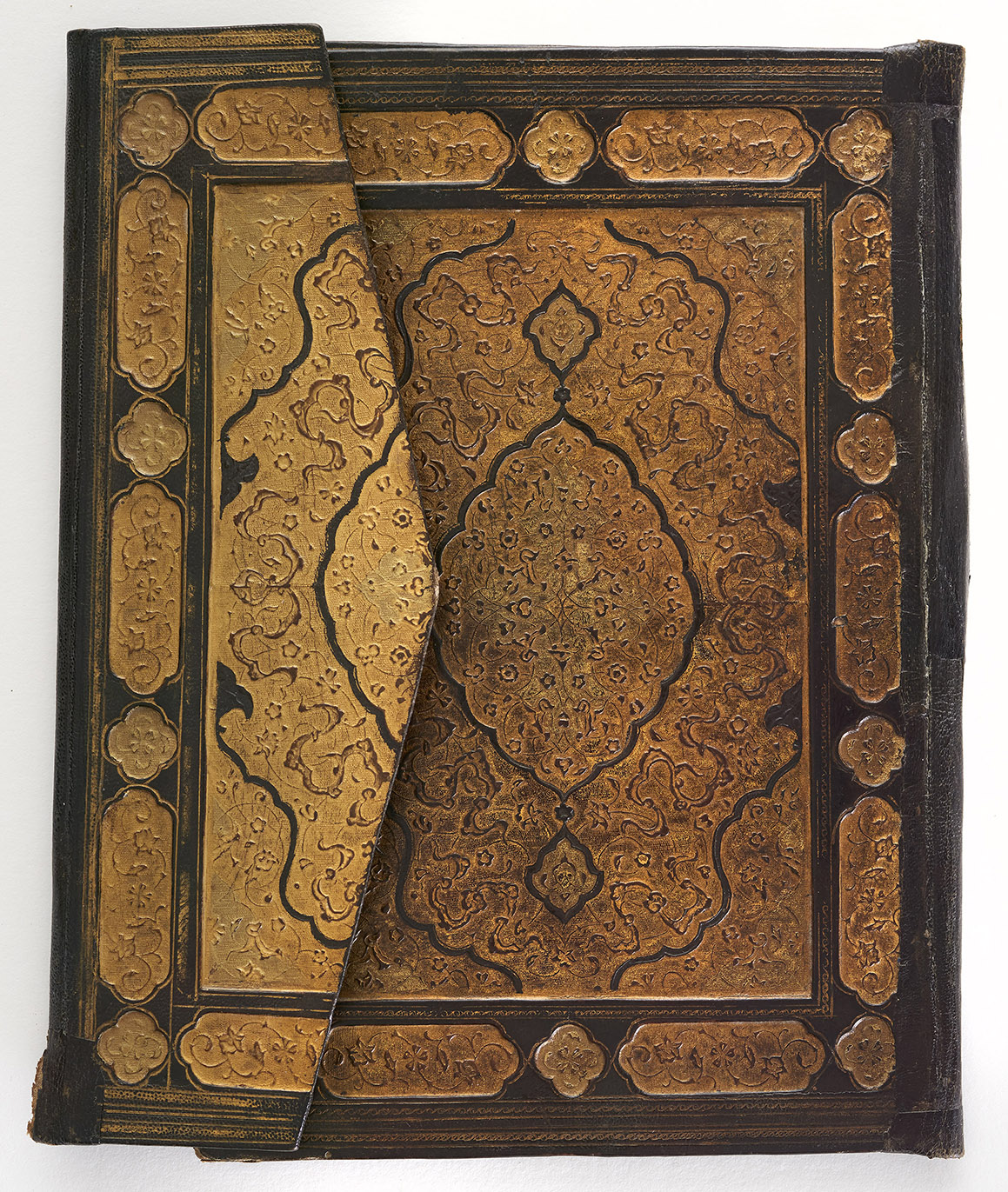Click on the image to zoom
Binding, outer covers and doublures: upper, lower, and flap
- Accession Number:AKM388
- Place:Iran
- Dimensions:38.2 cm × 20.3 cm
- Date:ca. 1580
- Materials and Technique:Dark and light chestnut and plum-coloured leather, pasteboard, gold, blue, black, and red paint
Durable yet easily decorated, leather presented an ideal material for protecting Islamic manuscripts. Some particularly fine bindings executed in the 15th century even featured different designs on the upper and lower covers.[1] Delicate leather filigree was often reserved for inner covers (doublures), where it would be less susceptible to damage.
Further Reading
Like AKM387 this binding must have been produced in the Khurasan region of Iran during the Safavid period (1501–1722). However, its date of creation is probably later, around 1580.
The central field of the covers features a medallion with pendants and cornerpieces with a pendant in the form of a palmette. These are filled with branches and flowers of various sizes. The area between the medallion and cornerpieces is slightly sunken and decorated with a two-tier design: on the lower level are scrolling branches and flowers, some of which are fan-shaped; on the upper level are cloud motifs. The broad border is decorated with cartouches filled with flowers. The decoration is stamped and gilded with a reddish tone of gold. The border around the medallion and cornerpieces is ungilded. The inside of the medallion has been gilded in a yellow tone of gold, creating a cruciform shape. The gold paint on some of the flowers and clouds has worn away, revealing the light chestnut-coloured leather in places.
The fore-edge flap of the binding is decorated with a cartouche with pendants painted red. There is a stamped inscription in taliq inside the cartouche that says Kitab-i Mathnavi Jalali. In both form and decoration this cartouche is inconsistent with the rest of the decoration and may have been added in the course of repairs.
The plum-coloured leather doublures are decorated with an oval medallion with pendants in the centre and cornerpieces, while the fore-edge flap is filled with an oval medallion, and the flap with cornerpieces and a palmette-shaped cartouche at the centre. These cornerpieces and medallions are filled with light chestnut-coloured leather filigree in leaf-like scrollwork (evoking the rumi motif) laid over a blue ground. There is a cartouche across the centre of the medallion on both covers filled with a gilded filigree leather inscription reading "Allâhu ve lâ sivâhu" (There is God and none other than Him).
- Zeren Tanındı
Notes
[1] Oktay Aslanapa, “The Art of Bookbinding,” figs. 38, 48, 51; Julian Raby and Zeren Tanındı, Turkish Book Binding in the 15th Century. The Foundation of an Ottoman Court Style, 106–25, cat. 1–4.
References
Aslanapa, Oktay. “The Art of Bookbinding.” The Arts of the Book in Central Asia, 14th–16th Centuries, ed. Basil Gray. Paris and London: UNESCO/Serindia Publications, 1979, 59–92. ISBN: 9780877731658
Raby, Julian and Zeren Tanındı. Turkish Book Binding in the 15th Century. The Foundation of an Ottoman Court Style. London: Azimuth editions on behalf of l'Association Internationale de Bibliophilie, 1993. ISBN: 9781898592013
Note: This online resource is reviewed and updated on an ongoing basis. We are committed to improving this information and will revise and update knowledge about this object as it becomes available.








